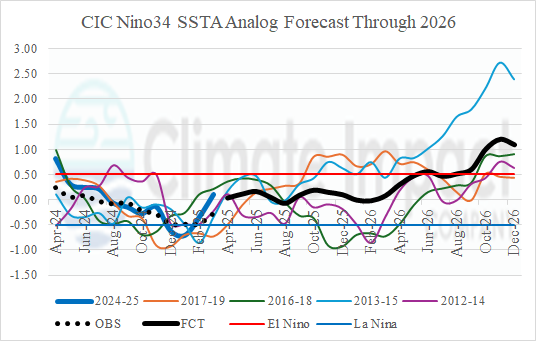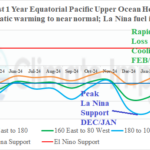
Warming East Pacific Leads to Wet Climate Bias Western South America
04/02/2025, 8:57 am EDT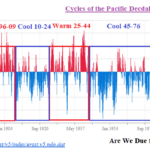
Are We Due for a Cycle Change of the Pacific Decadal Oscillation?
04/10/2025, 7:49 pm EDTHighlight: Below average forecast confidence yields neutral ENSO for 2025 although close monitoring is required; El Nino indicated for 2026.
Executive summary: The ENSO forecast is complex given the influence on the ENSO System by widespread warmer than normal SSTA in the middle latitudes (mostly) identified as marine heatwaves (MHW). Additionally, the subsurface equatorial upper ocean heat signature in April 2025 is relatively unique featuring a large mass of anomalous warm water near and west of the Dateline while a new area of shallow warming is strengthening off the northwest coast of South America. While the potential for El Nino development seems to be developing, the statistical and dynamic forecast models are only partially indicating weak El Nino potential and include a slight risk of weak La Nina returning later in 2025 while the consensus forecast is neutral ENSO through 2025. However, evidence to support El Nino return in 2026 is increasing.
Discussion: The Climate Impact Company constructed analog (CIC-CA) forecast using the Nino34 SSTA index indicates 2 potential scenarios in 2025: An emerging weak El Nino or a return of weak La Nina (Fig. 1). The multivariate ENSO index (MEI) CIC-CA forecast reveals mostly neutral ENSO for 2025 with a 1-in-5 chance of weak El Nino or weak La Nina (Fig. 2). Clearly, the specifics of the ENSO forecast are made with below average forecast confidence. However, confident is that the ENSO influence on climate pertaining to El Nino or La Nina is weak (or non-existent). The CIC-CA forecasts indicate El Nino is favored to develop during 2026.
A collection of dynamic and statistical Nino34 SSTA forecasts by the International Research Institute (IRI) for Climate and Society reveal a similar 2025 forecast scenario (Fig. 3). The consensus of a wide array of forecast solutions by the dynamic and statistical models is neutral ENSO phase for 2025. Interestingly, the outlier solutions favor returning La Nina later in 2025.
The global oceans are warm, featuring many MHW’s away from the tropics (Fig. 4). The subsurface is robustly warm near and west of the Dateline (Fig. 5). Normally, El Nino is produced by the warm subsurface Kelvin Wave west of the Dateline advancing eastward across the equatorial East Pacific. However, the eastward push of warming is not indicated. Instead, unusual warming of the shallow far eastern equatorial Pacific is occurring due to persistent westerly wind in the lower atmosphere through Q1/2025. The potential vertical velocity observations from March indicate lack of atmospheric support to change the ENSO phase (Fig. 6). Anticipated, although a low confidence forecast, the seasonality of increasing trade winds during the warm season in the deep tropics will cause the localized warming off the northwest coast of South America to weaken.
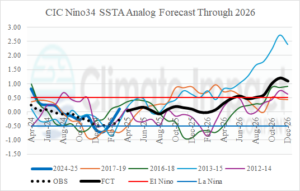
Fig. 1: The Climate Impact Company constructed analog forecast of Nino34 SSTA reveals neutral ENSO for 2025 and favors El Nino in 2026.
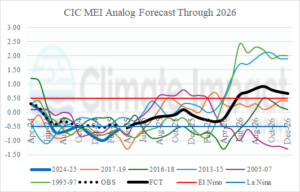
Fig. 2: The Climate Impact Company constructed analog forecast of multivariate ENSO index (MEI) reveals neutral ENSO for 2025 and favors El Nino in 2026.
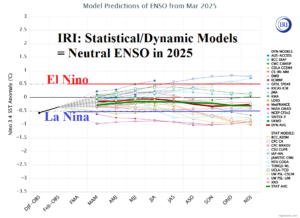
Fig. 3: International Research Institute (IRI) for Climate and Society collection of all dynamic and statistical Nino34 SSTA forecasts reveals neutral ENSO ahead for 2025.
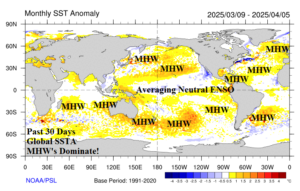
Fig. 4: Global SSTA observations from the past 30 days reveal the presence of many marine heat waves causing an unusually warm ocean surface away from the tropics.

Fig. 5: The subsurface equatorial Pacific Ocean indicates a stationary warm Kelvin Wave staying west of the Dateline, lingering cool waters from the late 2024 La Nina east of the Dateline, and recent emerging shallow warm waters off the northwest coast of South America.

Fig. 6: International Research Institute (IRI) for Climate and Society vertical velocity potential for March 2025 indicates neutral conditions and lack of push to cause an ENSO phase change.

